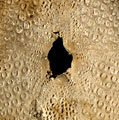The Echinoid Directory
Ravenelia McCrady, 1859, p. 283
| Diagnostic Features |
|
|---|---|
| Distribution |
|
| Name gender | feminine |
| Type | Pygorhynchus rugosa Ravenel, 1848, p. 4; by subsequent designation of Lambert & Thiery, 1921, p. 365. |
| Species Included |
|
| Classification and/or Status |
|
| Remarks |
|




